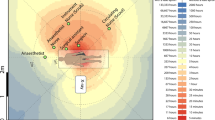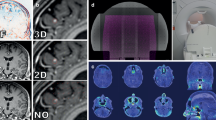Abstract
Given the existing literature on the subject, there is obviously a need for specific advice on quality assurance (QA) tolerances for departments using or implementing 3D printed bolus for radiotherapy treatments. With a view to providing initial suggested QA tolerances for 3D printed bolus, this study evaluated the dosimetric effects of changes in bolus geometry and density, for a particularly common and challenging clinical situation: specifically, volumetric modulated arc therapy (VMAT) treatment of the nose. Film-based dose verification measurements demonstrated that both the AAA and the AXB algorithms used by the Varian Eclipse treatment planning system (Varian Medical Systems, Palo Alto, USA) were capable of providing sufficiently accurate dose calculations to allow this planning system to be used to evaluate the effects of bolus errors on dose distributions from VMAT treatments of the nose. Thereafter, the AAA and AXB algorithms were used to calculate the dosimetric effects of applying a range of simulated errors to the design of a virtual bolus, to identify QA tolerances that could be used to avoid clinically significant effects from common printing errors. Results were generally consistent, whether the treatment target was superficial and treated with counter-rotating coplanar arcs or more-penetrating and treated with noncoplanar arcs, and whether the dose was calculated using the AAA algorithm or the AXB algorithm. The results of this study suggest the following QA tolerances are advisable, when 3D printed bolus is fabricated for use in photon VMAT treatments of the nose: bolus relative electron density variation within \(\pm 5\%\) (although an action level at \(\pm 10\%\) may be permissible); bolus thickness variation within \(\pm 1\) mm (or 0.5 mm variation on opposite sides); and air gap between bolus and skin \(\le 5\) mm. These tolerances should be investigated for validity with respect to other treatment modalities and anatomical sites. This study provides a set of baselines for future comparisons and a useful method for identifying additional or alternative 3D printed bolus QA tolerances.





Similar content being viewed by others
References
Vyas V, Palmer L, Mudge R, Jiang R, Fleck A, Schaly B, Osei E, Charland P (2013) On bolus for megavoltage photon and electron radiation therapy. Med Dosim 38(3):268–273
Łukowiak M, Boehlke M, Matias D, Jezierska K, Piatek-Hnat M, Lewocki M, Podraza W, El Fray M, Kot W (2016) Use of a 3D printer to create a bolus for patients undergoing tele-radiotherapy. Int J Radiat Res 14(4):287–295
Łukowiak M, Jezierska K, Boehlke M, Wiecko M, Łukowiak A, Podraza W, Lewocki M, Masojć B, Falco M (2017) Utilization of a 3D printer to fabricate boluses used for electron therapy of skin lesions of the eye canthi. J Appl Clin Med Phys 18(1):76–81
Sasaki DK, McGeachy P, Alpuche Aviles JE, McCurdy B, Koul R, Dubey A (2019) A modern mold room: meshing 3D surface scanning, digital design, and 3D printing with bolus fabrication. J Appl Clin Med Phys 20(9):78–85
Park SY, Choi CH, Park JM, Chun M, Han JH, Kim JI (2016) A patient-specific polylactic acid bolus made by a 3D printer for breast cancer radiation therapy. PLoS ONE 11(12):e0168063
Canters RA, Lips IM, Wendling M, Kusters M, van Zeeland M, Gerritsen RM, Poortmans P, Verhoef CG (2016) Clinical implementation of 3D printing in the construction of patient specific bolus for electron beam radiotherapy for non-melanoma skin cancer. Radiother Oncol 121(1):148–153
Park JW, Yea JW (2016) Three-dimensional customized bolus for intensity-modulated radiotherapy in a patient with Kimura’s disease involving the auricle. Cancer/Radiother 20(3):205–209
Kim SW, Shin HJ, Kay CS, Son SH (2014) A customized bolus produced using a 3-dimensional printer for radiotherapy. PLoS ONE 9(10):e110746
Ricotti R, Ciardo D, Pansini F, Bazani A, Comi S, Spoto R, Noris S, Cattani F, Baroni G, Orecchia R, Vavassori A (2017) Dosimetric characterization of 3D printed bolus at different infill percentage for external photon beam radiotherapy. Phys Med 39:25–32
Butson MJ, Cheung T, Yu P, Metcalfe P (2000) Effects on skin dose from unwanted air gaps under bolus in photon beam radiotherapy. Radiat Meas 32(3):201–204
Khan Y, Villarreal-Barajas JE, Udowicz M, Sinha R, Muhammad W, Abbasi AN, Hussain A (2013) Clinical and dosimetric implications of air gaps between bolus and skin surface during radiation therapy. J Cancer Ther 4(7):1251–1255
Su S, Moran K, Robar JL (2014) Design and production of 3D printed bolus for electron radiation therapy. J Appl Clin Med Phys 15(4):194–211
McGeachy P, Sasaki DK, Harris C, Sharma AM, Dubey A (2017) Quality assurance tests for 3D printed bolus used in radiation therapy. Int J Radiat Oncol Biol Phys 99(2):E697–E698
Burleson S, Baker J, Hsia AT, Xu Z (2015) Use of 3D printers to create a patient-specific 3D bolus for external beam therapy. J Appl Clin Med Phys 16(3):166–178
Zou W, Fisher T, Zhang M, Kim L, Chen T, Narra V, Swann B, Singh R, Siderit R, Yin L, Teo BKK (2015) Potential of 3D printing technologies for fabrication of electron bolus and proton compensators. J Appl Clin Med Phys 16(3):90–98
Kudchadker RJ, Antolak JA, Morrison WH, Wong PF, Hogstrom KR (2003) Utilization of custom electron bolus in head and neck radiotherapy. J Appl Clin Med Phys 4(4):321–333
Charles PH, Kairn T, Crowe SB (2020) Clinical quality assurance of 3D printed patient specific radiotherapy devices. Phys Eng Sci Med 43(1):436–437. https://doi.org/10.1007/s13246-019-00826-6. Correction to: EPSM 2019, Engineering and Physical Sciences in Medicine. Phys Eng Sci Med 43(1):463. https://doi.org/10.1007/s13246-020-00846-7
Dipasquale G, Poirier A, Sprunger Y, Uiterwijk JWE, Miralbell R (2018) Improving 3D-printing of megavoltage X-rays radiotherapy bolus with surface-scanner. Radiat Oncol 13(1):203
Maxwell SK, Charles PH, Cassim N, Kairn T, Crowe SB (2020) Assessing the fit of 3D printed bolus from CT, optical scanner and photogrammetry methods. Phys Eng Sci Med 43:601–607
Craft DF, Kry SF, Balter P, Salehpour M, Woodward W, Howell RM (2018) Material matters: analysis of density uncertainty in 3D printing and its consequences for radiation oncology. Med Phys 45(4):1614–1621
Albantow C, Hargrave C, Brown A, Halsall C (2020) Comparison of 3D printed nose bolus to traditional wax bolus for cost-effectiveness, volumetric accuracy and dosimetric effect. J Med Radiat Sci 67(1):54–63
Alderson SW, Lanzl LH, Rollins M, Spira J (1962) An instrumented phantom system for analog computation of treatment plans. Am J Roentgenol Radium Ther Nucl Med 87:185–195
Binny D, Kairn T, Lancaster CM, Trapp JV, Crowe SB (2018) Photon Optimizer (PO) versus Progressive Resolution Optimizer (PRO): a conformality and complexity based comparison for Intensity Modulated Arc Therapy plans. Med Dosim 43(3):267–275
Tino R, Leary M, Yeo A, Brandt M, Kron T (2019) Gyroid structures for 3D-printed heterogeneous radiotherapy phantoms. Phys Med Biol 64:21NT05
Dancewicz OL, Sylvander SR, Markwell TS, Crowe SB, Trapp JV (2017) Radiological properties of 3D printed materials in kilovoltage and megavoltage photon beams. Phys Med 38:111–118
Ahnesjo A, Aspradakis MM (1999) Dose calculations for external photon beams in radiotherapy. Phys Med Biol 44(11):R99–R155
Dunn L, Lehmann J, Lye J, Kenny J, Kron T, Alves A, Cole A, Zifodya J, Williams I (2015) National dosimetric audit network finds discrepancies in AAA lung inhomogeneity corrections. Phys Med 31(5):435–441
Crowe SB, Kairn T, Trapp JV, Fielding AL (2013) Monte Carlo evaluation of collapsed-cone convolution calculations in head and neck radiotherapy treatment plans. IFMBE Proc 39:1803–1806. https://doi.org/10.1007/978-3-642-29305-4_474
Cignoni P, Callieri M, Corsini M et al (2008) MeshLab: an open-source mesh processing tool. In: Sixth Eurographics Italian Chapter conference, pp 129–136
Cignoni P, Rocchini C, Scopigno R (1998) Metro: measuring error on simplified surfaces. Comput Graph Forum 17(2):167–174
Aland T, Kairn T, Kenny J (2011) Evaluation of a Gafchromic EBT2 film dosimetry system for radiotherapy quality assurance. Australas Phys Eng Sci Med 34(2):251–260
Spelleken E, Crowe SB, Sutherland B, Challens C, Kairn T (2018) Accuracy and efficiency of published film dosimetry techniques using a flat-bed scanner and EBT3 film. Australas Phys Eng Sci Med 41(1):117–128
Kairn T (2021) Applying good software development processes in practice. In: Helmenkamp J, Bujila R, Poludniowski G (eds) Diagnostic radiology physics with MATLAB: a problem-solving approach. CRC Press, Boca Raton. https://doi.org/10.1201/9781351188197
Schneider CA, Rasband WS, Eliceiri KW (2012) NIH Image to ImageJ: 25 years of image analysis. Nat Methods 9(7):671–675
Bastawrous S, Wu L, Strzelecki B, Levin DB, Li JS, Coburn J, Ripley B (2021) Establishing quality and safety in hospital-based 3D printing programs: patient-first approach. Radiographics 41(4):1208–1229
Chepelev L, Wake N, Ryan J, Althobaity W, Gupta A, Arribas E, Santiago L, Ballard DH, Wang KC, Weadock W, Ionita CN (2018) Radiological Society of North America (RSNA) 3D Printing Special Interest Group (SIG): guidelines for medical 3D printing and appropriateness for clinical scenarios. 3D Print Med 4:11
Leng S, McGee K, Morris J, Alexander A, Kuhlmann J, Vrieze T, McCollough CH, Matsumoto J (2017) Anatomic modeling using 3D printing: quality assurance and optimization. 3D Print Med 3:6
Van Esch A, Tillikainen L, Pyykkonen J, Tenhunen M, Helminen H, Siljamäki S, Alakuijala J, Paiusco M, Iori M, Huyskens DP (2006) Testing of the analytical anisotropic algorithm for photon dose calculation. Med Phys 33(11):4130–4148
Vassiliev ON, Wareing TA, McGhee J, Failla G, Salehpour MR, Mourtada F (2010) Validation of a new grid-based Boltzmann equation solver for dose calculation in radiotherapy with photon beams. Phys Med Biol 55(3):581–598
Fogliata A, Nicolini G, Clivio A, Vanetti E, Cozzi L (2011) Dosimetric evaluation of Acuros XB Advanced Dose Calculation algorithm in heterogeneous media. Radiat Oncol 6(1):82
Kairn T, Livingstone AG, Crowe SB (2020) Monte Carlo calculations of radiotherapy dose in “homogeneous” anatomy. Phys Med 78:156–165. https://doi.org/10.1016/j.ejmp.2020.09.019
Ramachandran P, Tajaldeen A, Roozen K, Wanigaratne D, Taylor D, Kron T (2016) A study of dose calculation algorithms using an IPSM phantom with different density materials for in-field and out-of-field conditions. Australas Phys Eng Sci Med 39(4):1177–1178. https://doi.org/10.1007/s13246-016-0494-2
Acknowledgements
This work would not have been possible without the support of Steven R. Sylvander, whose commitment and enthusiasm carried 3D printing into the Department of Radiation Oncology at the Royal Brisbane and Women’s Hospital.
Funding
Contributions to this work from Scott B. Crowe, Paul Charles and Tania Poroa were supported by a Metro North Hospital and Health Service funded Herston Biofabrication Institute Programme Grant (no grant number).
Author information
Authors and Affiliations
Corresponding author
Ethics declarations
Conflict of interest
All authors declare that they have no conflicts of interest.
Ethical approval
This article does not contain any studies with human participants performed by any of the authors.
Rights and permissions
About this article
Cite this article
Kairn, T., Talkhani, S., Charles, P.H. et al. Determining tolerance levels for quality assurance of 3D printed bolus for modulated arc radiotherapy of the nose. Phys Eng Sci Med 44, 1187–1199 (2021). https://doi.org/10.1007/s13246-021-01054-7
Received:
Accepted:
Published:
Issue Date:
DOI: https://doi.org/10.1007/s13246-021-01054-7




